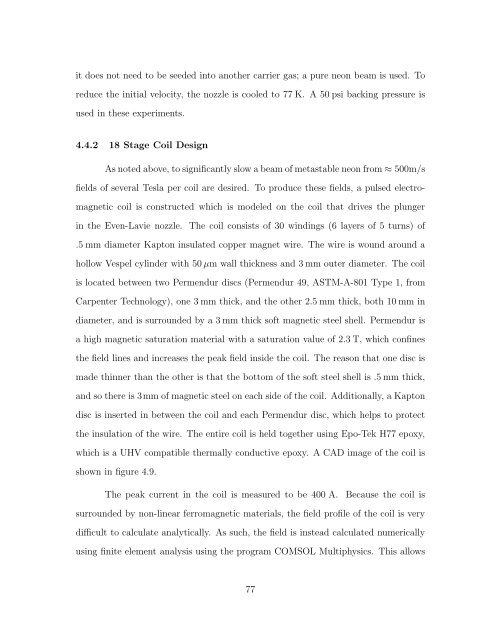Experiments with Supersonic Beams as a Source of Cold Atoms
Experiments with Supersonic Beams as a Source of Cold Atoms
Experiments with Supersonic Beams as a Source of Cold Atoms
Create successful ePaper yourself
Turn your PDF publications into a flip-book with our unique Google optimized e-Paper software.
it does not need to be seeded into another carrier g<strong>as</strong>; a pure neon beam is used. To<br />
reduce the initial velocity, the nozzle is cooled to 77 K. A 50 psi backing pressure is<br />
used in these experiments.<br />
4.4.2 18 Stage Coil Design<br />
As noted above, to significantly slow a beam <strong>of</strong> met<strong>as</strong>table neon from ≈ 500m/s<br />
fields <strong>of</strong> several Tesla per coil are desired. To produce these fields, a pulsed electro-<br />
magnetic coil is constructed which is modeled on the coil that drives the plunger<br />
in the Even-Lavie nozzle. The coil consists <strong>of</strong> 30 windings (6 layers <strong>of</strong> 5 turns) <strong>of</strong><br />
.5 mm diameter Kapton insulated copper magnet wire. The wire is wound around a<br />
hollow Vespel cylinder <strong>with</strong> 50 μm wall thickness and 3 mm outer diameter. The coil<br />
is located between two Permendur discs (Permendur 49, ASTM-A-801 Type 1, from<br />
Carpenter Technology), one 3 mm thick, and the other 2.5mmthick, both10mmin<br />
diameter, and is surrounded by a 3 mm thick s<strong>of</strong>t magnetic steel shell. Permendur is<br />
a high magnetic saturation material <strong>with</strong> a saturation value <strong>of</strong> 2.3 T, which confines<br />
the field lines and incre<strong>as</strong>es the peak field inside the coil. The re<strong>as</strong>on that one disc is<br />
made thinner than the other is that the bottom <strong>of</strong> the s<strong>of</strong>t steel shell is .5mm thick,<br />
and so there is 3mm <strong>of</strong> magnetic steel on each side <strong>of</strong> the coil. Additionally, a Kapton<br />
disc is inserted in between the coil and each Permendur disc, which helps to protect<br />
the insulation <strong>of</strong> the wire. The entire coil is held together using Epo-Tek H77 epoxy,<br />
which is a UHV compatible thermally conductive epoxy. A CAD image <strong>of</strong> the coil is<br />
shown in figure 4.9.<br />
The peak current in the coil is me<strong>as</strong>ured to be 400 A. Because the coil is<br />
surrounded by non-linear ferromagnetic materials, the field pr<strong>of</strong>ile <strong>of</strong> the coil is very<br />
difficult to calculate analytically. As such, the field is instead calculated numerically<br />
using finite element analysis using the program COMSOL Multiphysics. This allows<br />
77
















